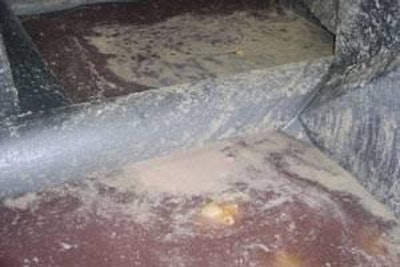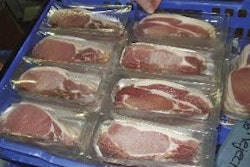
Chlorine in the forms of sodium hypochlorite, calcium hypochlorite tablets or chlorine gas is by far the most commonly used carcass and equipment disinfectant in the poultry industry in the USA and many other countries. In the USA, USDA Food Safety and Inspection Service (FSIS) allows for addition of chlorine to processing waters at levels up to 50ppm in carcass wash applications and chiller make-up water. FSIS also requires that chlorinated water containing a minimum of 20ppm available chlorine be applied to all surfaces of carcasses when the inner surfaces have been re-processed (due to carcass contamination) other than solely by trimming.
With recent emphasis by FSIS on further reducing salmonella, poultry plants have increased their reliance on later chlorination programmes including pre-scald bird brushes, equipment rinses, inside/outside bird washers, carcass washes and as a disinfectant during chilling. Water chlorination is poorly understood in the poultry industry.
Chlorine is used in three common forms for water treatment: elemental chlorine (chlorine gas), sodium hypochlorite (NaOCl; bleach) solution and dry calcium hypochlorite pellets. The amount of hypochlorite (OCl) varies depending on the type of chlorine used. One kilogramme (1kg) of Cl2 generates 8.35 litres of 12.5% NaOCl and 1.5kg of Ca(OCl)2 (65%).
At recommended levels, hypochlorite-based (chlorine derivative) sanitisers reduce both enveloped and non-enveloped viruses. Chlorine is also effective against fungi, bacteria and algae but not bacterial spores.
Types of chlorine used
Chlorine gas
Chlorine in its elemental state is a halogen gas (Cl2), which is highly toxic and corrosive. Because of safety concerns with chlorine gas, many food processing facilities have changed to either sodium hypochlorite or calcium hypochlorite for water treatment.
Chlorine gas and sodium hypochlorite can be produced in an electrochemical process. Chlorine gas is passed through sodium hydroxide solution (NaOH), producing sodium chloride (NaCl; common salt), NaOCl and water as shown in the following equation:
2 NaOH + Cl2 (g) = NaCl + NaOCl + H2O.
Sodium hypochlorite is the most stable and cheapest form of chlorine available.
Sodium hypochlorite
In most food plants, chlorine is purchased as sodium hypochlorite used in a solution containing 5-30% NaOCl. (Household bleach contains 5.25% NaOCl). Commercial forms of NaOCl are provided in a range of concentrations of 3-50%. The most commonly used form in poultry processing plants worldwide is commercial bleach., which contains 12.5% NaOCl.
Calcium hypochlorite
Available in granular or pellet form, calcium hypochlorite can be more expensive than other hypochlorite forms but some companies prefer it because they can control the concentration more effectively than using other forms of chlorine.
Chlorine-based sanitisers are very low in cost and can control bacteria in food processing plants when used appropriately. The advantages and disadvantages of using chlorine sanitisers are listed in Table 1.
Germicidal mechanism & effects
Chlorine has a broad spectrum of activity against bacteria. Its mode of action includes biosynthetic alterations in cellular metabolism and phospholipid destruction, formation of chloramines that interfere in cellular metabolism, oxidative action with irreversible enzymatic inactivation in bacteria, and lipid and fatty acid degradation. Chlorinated cells undergo a decrease in respiration that is not immediately reversed in the presence of reducing agents (elimination of the chlorine compounds). Chlorine also acidifies bacterial cells. Bacteria are unable to develop resistance to chlorine, making it a very effective sanitiser.
Concentration effect
FSIS requires a level of 20-50ppm chlorine in the chiller unless alternative treatments have been approved. Bacterial elimination depends on the concentration of chlorine and contact time. For example, bacterial reduction will be greater in chill systems than spray systems because of the greatly increased contact time (45-60 minutes versus a couple of minutes). The concentration of chlorine, however, is not nearly as important as the amount of organic material in the water in relation to the concentration of chlorine. For example, in municipal water systems where very little organic material is present in the water, 1-2 ppm chlorine is effective for eliminating bacteria, whereas 50ppm may not be sufficient in poultry chill systems where high organic loads are encountered.
Efficacy and pH
In order to obtain maximum results, chlorine disinfectants must remain in contact with surfaces for several minutes. The pH of the water used for dilution should be below 6.5 to be most effective. Figure 1 shows the percentage of hypochlorous acid formed in waters at different pH levels and temperatures.
Because the hypochlorous acid is much more effective at killing bacteria than the hypochlorite ion (-OCl), the pH of chill systems and equipment sprays should be kept below 6.5. This is accomplished by adding acids such as citric acid or sodium acid sulphate or by adding carbon dioxide gas (CO2). Carbon dioxide may be obtained by piping gas from the tanks used to make CO2 snow' for packaging. Carbon dioxide, when in contact with water, forms carbonic acid and lowers the pH of the water. In general, the chiller should be maintained above pH5 in order to prevent corrosion of equipment.
Effect of organic load
A major consideration when using chlorine as a disinfectant is that free chlorine (hypochlorous acid, hypochlorite ion or elemental chlorine) is highly reactive and rapidly oxidises, bleaches or otherwise reacts with any number of substances such as fat, blood, faecal material and protein. Chlorine encounters high organic loads in poultry processing facilities, regardless of whether it is used on carcasses in chiller systems or on equipment surfaces. Poultry processing water may have extremely high levels of total organic carbon (TOC) and a correspondingly high chemical oxygen demand (COD).
Poor bleed-out, excessive scalder temperatures, poor washing of carcasses during and after evisceration and excessive faecal caking on the surface of the chickens coming into the plant may contribute to organic loading of the chiller systems. High scald temperatures can cause melting of the sub-skin fat that leaks into the chiller and begins to coagulate at colder temperatures. Any free chlorine added to these high-demand waters becomes unavailable for disinfection. If the COD in these waters is not satisfied, then a free-chlorine residual cannot be established.
A typical poultry chiller may have a chlorine demand of 1000-2000ppm that cannot be overcome by 50ppm chlorine in the make-up water the maximum allowable by USDA. Experiments conducted at the USDA's Western Regional Research Center, Agricultural Research Service concluded that a free chlorine residual could not be established in a commercial poultry chiller even by adding up to 400ppm of free chlorine.
When chlorine reacts with organic material, it generally loses its microbiocidal properties, and can no longer act as a disinfectant. Therefore, in order to maximise chlorine use in poultry chillers, efforts should be made to reduce the amount of organic material. Pre-scald bird brushes, effective carcass rinse systems, proper bleed-out procedures, counter-current scalders and chillers, proper fresh water make-up in scalders and chillers all contribute to lowering organic loading of the chillers.
| Table 1. Advantages and disadvantages of sodium hypochlorite use in poultry processing | |
| Advantages | Disadvantages |
| Low cost | Activity greatly influenced by pH |
| Familiar proven technology | Irritating agent |
| Relatively non-toxic | Inactivated by organic matter |
| Wide germicidal activity | Less active at low temperature |
| Effective at low concentrations | Carcinogenic byproducts |
| Bacteria cannot become resistant | Highly corrosive |
| Highly corrosive | Not accepted in Canada or Europe |
Dangers of disinfection by-products
The widespread use of free available chlorine (FAC) as a disinfectant in food processing has raised food safety concerns regarding the potential for trihalomethane (THM) formation and chlorine incorporation into the food. THM compounds have been implicated as possible cancer-causing agents. Several studies have reported on incorporation of chlorine into beef, pork, chicken and shrimp. Immersion of shrimp in 150ppm chlorine for 30 minutes resulted in 2% of the FAC being incorporated into the shrimp, and 75% of this amount was detectable in the edible portion. Chlorine binds more readily to unsaturated fatty acids. The fact that poultry is high in unsaturated fatty acids coupled with other research, which found HOCl to have the ability to destroy antioxidants, further raised the level of concern with the widespread use of FAC in the poultry processing industry.
FSIS allows the addition of chlorine to poultry processing water at levels of up to 50ppm in carcass wash applications and chiller make-up water. If an immersion chiller is treated directly, the concentration of FAC in the chiller must be less than 50ppm before the first carcass exits the chiller, and after the carcasses have started exiting the chiller, the FAC in the water returning from the red water chilling system must be less than 5ppm before that water re-enters the chiller.
Research has shown that an FAC residual in a loaded immersion chiller cannot be established under practical conditions. One study demonstrated that the addition of 400ppm FAC to equilibrated chiller water was insufficient in establishing an FAC residual since the chlorine demand in the chiller exceeded the 400ppm dose. The entire amount of added FAC was consumed in the chiller, some of which reacted with chiller contents such as ammonia and organic amines from the chicken carcasses to form various chlorinous compounds such as the beneficial biocide monochloramine and undesired non-biocidal organic chloramines. Since none of the added FAC remained as free chlorine, the total chlorine content of the chiller comprised entirely combined chlorine. The use of FAC as a chiller chlorination control measure does not capture the combined chlorine component of the water.
Odour problems
Some poultry processors have experienced a problem with chlorine-containing compounds released as gases (gassing off'), causing FSIS to shut the line. This problem has been closely linked to the addition of ammonia to the water by municipal water treatment facilities to prevent scale build-up. Ammonia in the water, upon contact with the chlorine added by the processor, can form di- and tri-chloramines (nitrogen di- or tri-chloride). These gaseous compounds are objectionable, causing burning of the eyes and throat. Even when chlorine is added at very low concentrations (20ppm), FSIS may still require plants to stop the line because of the bad odours. This is a city water problem and not a plant problem.
Effective and widely used for now
Chlorine has been and continues to be an effective means of reducing bacteria on equipment surfaces and poultry carcasses. External pressures such as concern about the formation of carcinogens, gassing off and employee safety, the effect of organic loading on the efficacy, and international restrictions may spell the eventual demise of this disinfectant. Because of its low cost, ease of use and availability, however, it is still the most widely used disinfectant in the industry.
The information in this article should assist processors in ensuring that they are getting the most out of the chlorine they are using in various applications throughout the plant.
References are available on request


.jpg?auto=format%2Ccompress&fit=crop&h=167&q=70&w=250)














